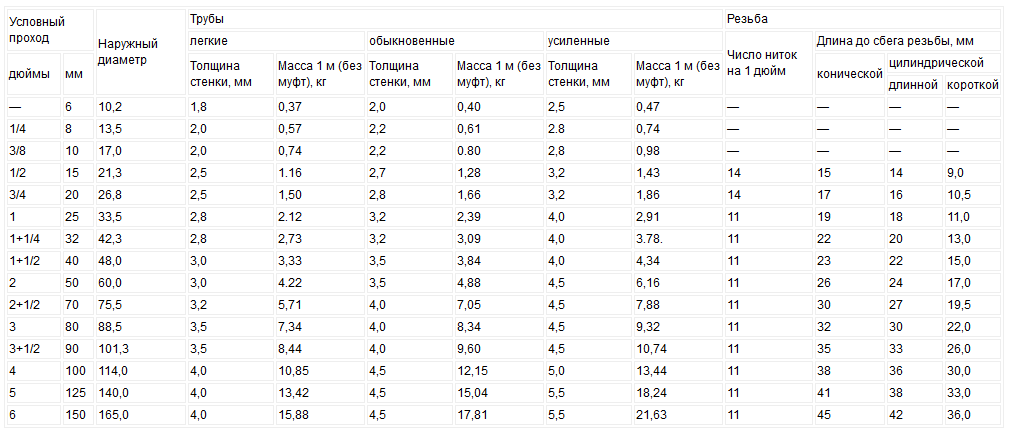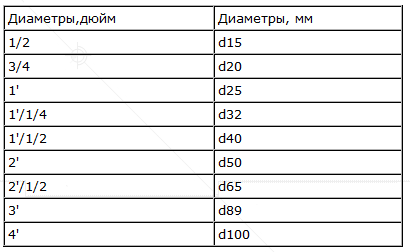In the life of a modern person, it is thanks to the water supply that the proper level of comfort is ensured. However, close attention is paid to pipes only when the system is not working. But you can avoid troubles or breakdowns if you immediately choose the right pipe diameter for the water supply in a private house or in an apartment - this will help ensure the necessary throughput and reliability of the pipeline.
If the dimensions of the pipes are less than necessary, then the network will have a constantly high pressure, due to which even breakdowns of plumbing devices are possible. Exceeding the required dimensions also has a negative effect - in particular, it significantly increases the cost of the structure.
- metal (steel, copper, cast iron, their various compounds);
- polymeric materials - plastic, polyethylene, metal-plastic, PVC;
- combinations of metal and plastic structures.
Whatever the characteristics of the materials, the dimensions will also be important. In particular, the diameter plastic pipes for a water supply system (metal and metal-plastic ones, too), they are divided into external and internal, and the throughput of the pipeline depends on it and the thickness of the walls.
Certain material characteristics also affect the working pressure level. In particular, steel is characterized by reliability and strength, but is susceptible to corrosion, and is also very heavy, and therefore the installation of the system is difficult. Also, limescale can accumulate inside the steel pipeline - therefore, the diameter will decrease, and the permeability of the system will fall.
The plastic is characterized by low weight, simple and easy installation. Such pipes do not accumulate plaque inside and do not rust, they are inexpensive and plastic. If the pipes are plastic, without a metal layer, then they can expand due to heating, but in metal-plastic products this drawback is excluded.
How to choose a diameter depending on the length of the water supply
The dimensions of the pipelines are characterized by the following parameters:
- inner diameter: selected the same for both fittings and pipes;
- nominal bore diameter - nominal parameter in mm required by installers;
- nominal diameter;
- outside diameter;
- wall thickness;
- the length of the pipes themselves.
Regardless of the material, both for steel and for polypropylene pipes for water supply, the diameter must be selected correctly, otherwise turbulization of the flow will occur in the system, and you will encounter constant noise in the system.
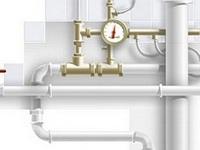
To determine which pipe diameter to use for a water supply system, depending on the length of the network being created, you need to take into account the average flow rate (in a standard water supply system it is 0.02 km / s). There are also standard recommendations:
- Systems less than 10 meters in length are constructed from pipes with a diameter of 20 mm.
- For networks less than 30 m long, the pipe diameter should be 25 mm.
- When the length of the system exceeds 30 meters, it is better to use pipes with a diameter of 32 mm.
As for the standard length of the pipes themselves, it can be from 4 to 15 m. In order for the pipeline to be of high quality and reliability, all its elements, including fittings, must be characterized by high performance indicators.
How pipe diameter affects throughput
The diameter of the pipe for the water supply in a private house or an apartment building determines the throughput of the system. For example, a pipe network with a diameter of 25 mm is able to pass 30 liters per minute, and a pipe of 32 mm - 50 liters. However, it is worth taking into account the throughput of the mixer, which does not exceed 5 l / min.
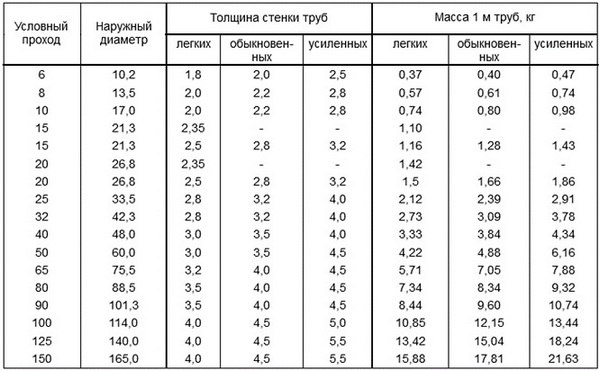
The calculation of the diameter of a pipe for water supply is also influenced by the number of points of water consumption - the more there are, the larger the diameter of the pipeline. In addition, how to choose the diameter of the pipe for the water supply is also influenced by such factors as:
- temperature of the transported medium (pipes for hot water must be thick-walled);
- the number of turns and joints in the system;
- working pressure (water pressure).
Note: If you plan to create a system with big amount joints, many turns, pressure drops, then you will need to choose pipes with an increased diameter. Dimensions also increase as water consumption increases.
If joining of steel and polymer water pipes, then standard adapters-fittings will come in handy - they are chosen so that the diameter of the elements corresponds to both standard sizes. This can be challenging if aluminum and copper products are expected to be handled as they are manufactured to metric standards. So you should carefully check the metric dimensions of the outside and inside diameters and relate them to inches.
The table in the photo below clearly demonstrates how the diameter of the water pipes correlates.
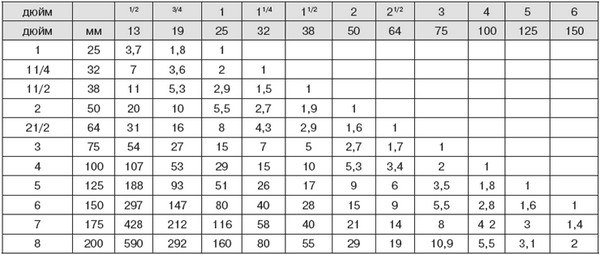
Read about that in our separate article. Considering the pros and cons of different options.
If you settled on polypropylene pipes, then you will also need to pick up a soldering iron for their installation. Information about this.
How to perform a hydraulic calculation of a water supply
It is very important to find out the throughput of the pipeline. This indicator demonstrates a metric characteristic - with its help, the amount of the limiting volume of liquid that can pass through the pipe section in a certain unit of time is calculated.
With the advent of metal-plastic and polymer water pipes, the calculation of the throughput of the pipe began to be carried out somewhat differently - after all, they are not covered with limescale and other multilayer deposits, do not corrode, that is, do not change the inner diameter during operation, and do not lead to losses of the transported medium. If we talk about steel pipesah, they are durable, but over time their capacity decreases.
Determination of the throughput allows you to calculate the volume of the transported liquid, select the method of connecting plumbing equipment, select water pipes of the appropriate diameter. If this is not done, then the engineering network will malfunction during operation - it is even possible that you turn on the tap in the bathroom, and the water will disappear in the kitchen.
What does the concept include hydraulic calculation? This implies:
- selection of materials for pipes;
- determination of the length of the pipeline;
- calculation of the number of points of water consumption and the number of plumbing equipment;
- determination of the throughput of pipes.
There are three methods for calculating the throughput of a pipe depending on the diameter and other parameters:
- Using formulas... For them, average indicators are used, including the roughness coefficient, which depends on the specific type of pipes. For example, for new metal pipes, this factor will be 0.2. Also, to calculate the throughput, the following parameters are useful - the material and diameter of the water pipe, the slope under which the non-pressure pipeline is laid, or the supply pressure of the transported medium.
- Using tabular information... They contain indicators for each specific material. For example, Shevelev's table contains information about plastic, steel, asbestos-cement and glass pipes.
- Using water supply optimization programs... This is the most modern and convenient method, since the programs contain many parameters required for the calculation. It works according to the following principle: you need to enter all the requested information and wait for the result to be received. With the massive connection of water intake points, it is the program that will be the optimal calculation method for an integral water supply network. Among the information that the program uses is the inner diameter of the pipe, the length of the entire section, the roughness coefficient for the selected pipeline material, the coefficient of local resistance in fittings (tees, bends, and so on), the amount of diameter reduction during operation.
It is better to use tabular information or programs for the calculation. As a result, you will be able to correctly calculate the required pipeline diameter and equip the system with all the necessary accessories, including expansion joints. Knowing how to choose the diameter of the pipe for the water supply will provide you with a good pressure when supplying water, as well as no change in pressure when using multiple taps.
The water supply should be organized in such a way that residents can count on a certain amount of water with a reserve. For this, it is important to have durable and strong pipes for the water supply system installed in a private house. Moreover, they must be resistant to corrosion damage and the loading pressure of the water circulation.
Types of pipes for water supply and their choice
In order to choose the right pipes for the water supply of a private house, the following parameters should be taken into account:
strength;
life time;
resistance to temperature changes;
installation characteristics.
First of all, the owners should decide on the material of the plumbing. The most common and for conducting plumbing in the house are:
metal-reinforced plastics;
steel;
PVC products;
polyethylene.
Let's consider each type separately.
Copper piping
This option is expensive, but it has all the advantages over products of other compositions. The material is not subject to corrosion, does not affect the taste of water and is resistant to water pressure in a private house.
Copper, in contact with chlorine, neutralizes its chemical effects. In addition to this quality, such pipes for the pipeline have a pleasant appearance and an average diameter. With such properties, there is no need to hide them under the wall plaster in a private house. Among the disadvantages there are two points: the high cost and the impossibility of an independent welding process in case of depressurization of the system elements.
Reinforced plastic piping
It consists of an aluminum alloy, protected by polyethylene on both sides. The smooth surface makes it possible not to accumulate chlorine impurities on the walls.
A layer of polyethylene on the surface protects against condensation. Among the disadvantages can be noted instability to increased temperature exposure.
Steel plumbing
Steel pipes for plumbing are characterized by such advantages as long service life and strength. Among the disadvantages are increased corrosivity. During installation, notches are made on the pipes for sealing, or welding is required, which delays the installation process.
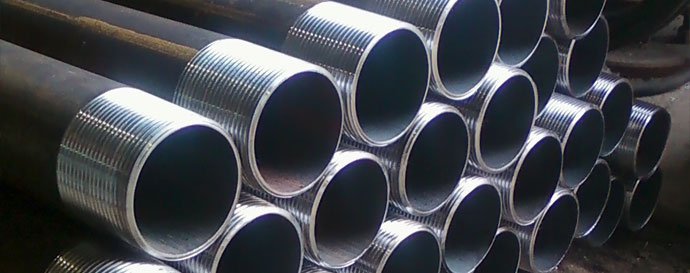
These pipes are used for water supply for the heating system, sewerage. The terms of use are 25 years. Steel products have more disadvantages than advantages, and they are expressed in defenselessness against deformation by corrosion, large size and heavy weight, as well as blockage by deposits during operation.
PVC products
These pipes for the pipeline are widely in demand among the owners of country cottages. The biggest advantage of the material is its durability and ease of installation. The strength of the connection does not require additional couplings and notches, which allows them to be safely disguised under a layer of concrete.
The downside is the presence of a special welding inverter for polypropylene in case they are connected. PVC products are successfully used for heating and water supply in a private house.
Polyethylene products
They consist of a modification of plastic, which, according to its characteristics, takes first place among plastic products. Plumbing pipes made of such material are hardy and reliable.
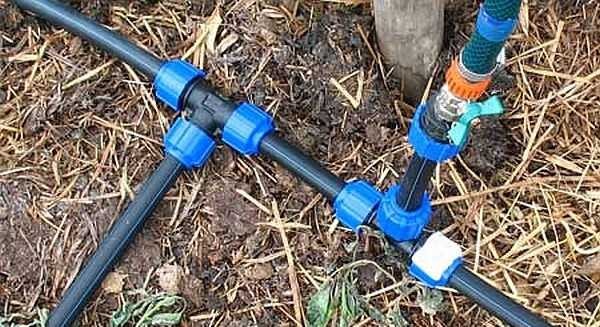
Possessing thermal insulation properties, they are not afraid of the transition from hot to cold liquid. Parts for plumbing are produced from polyethylene of standard size, in long lengths for ease of assembly.
In winter, the presence of water in the pipelines in a private house does not lead to their destruction. Polyethylene pipes are used for laying the system underground in a private house.
Diameter selection
One of the important factors when choosing a pipeline for country house is their diameter:
For a water supply system with a length of less than 30 cm, pipes with a diameter of 20 mm will fit.
If the pipe line exceeds 30 cm, the diameter is selected at 34 mm.
For a small section of the pipe line to be laid, no more than 10 meters, a pipe with a diameter of 20 mm is used.
For metal-plastic, the diameter of the inner part is small, but the circulation of the liquid does not decrease.
This material is resistant to high loads. Installation in a private house can be done independently, thanks to the lightness and the included fastening rings.
If necessary, the system can be easily disassembled. It is also possible to parse individual sections in case of a blockage in the pipeline in the house.
Underground laying
Pipes for water supply running in the ground can be used polyvinyl chloride, polyethylene, polypropylene. Such products will serve their owners for a long time and reliably, without the need for repair and maintenance. Convenience for installation will be an unreinforced section that easily connects to the fitting. To seal the joints of PVC products, glass fiber can be used, which is easily melted and promotes strong bonding.
For accurate sizing, it is worth considering the average head, where in standard pipes the diameter is 0.02 km / s. The standard diameter of the water supply itself is from 5 to 12 meters.
If you plan to equip a complex system in a private house that has a large number of turns and bends, you should give preference to pipes with a maximum circumference. The diameter of the pipes should be larger as the amount of water is consumed.
To the choice of pipes for water supply, one should take into account such important indicators as:
- the maximum possible temperature of the transported water,
- features of the material used in their production,
- nominal working pressure,
- diameter of water supply pipes.
If you ignore the last indicator, in the future it can threaten with such negative consequences as decrease in efficiency operation of the entire water supply system, insufficient network bandwidth, breaks and breakdowns in water pipelines.
Diameter of water supply pipes made of different materials is selected according to the measurement classification.
Sizes of steel pipes are presented in inches, and they correspond to the inner diameter. For example, a two-inch or 1.5-inch steel pipe has a diameter in millimeters of 24.4 and 12.7, respectively.
However, the installation of water supply and sewerage should be carried out taking into account the outer size of the pipe, since it is on the outside of the pipe that there is a thread. To determine the outside diameter of pipes, consider the inside and wall thickness. A special thread system will help you figure this out. For example, for metric threadM14 the outer diameter of the water supply pipes is 14 mm, for the M12 thread - 12 mm. For pipe threads, things are a little different. Half-inch (1/2 ″) pipe with different threads will have an outer diameter of 12.7 mm.
Of course, the distribution of water supply pipes cannot be performed with pipes whose diameter is larger than the riser. The larger the pipe size is chosen, the better the head will be. Only an accurate calculation can guarantee the correct choice.
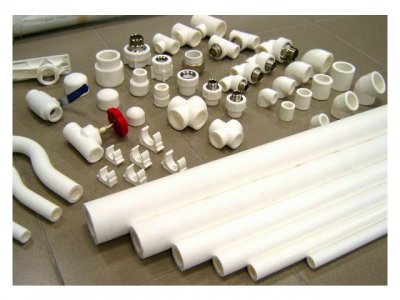
Complex installation of water supply, involving many turns and joints, as well as laying pipes over long distances, can face a problem insufficient pressure in system. In this case, it makes sense to carry out installation using pipes of a larger diameter.
Video instruction on how to choose a pipe for heating.
The modern market offers a wide range of materials that are used installation of water supply and sewerage. The most popular are metal-plastic and plastic pipes. As a result, for everyone who decided to improve their home, the question arises of how to correctly determine the diameter of the water supply pipes, especially if the joining of water supply elements from different materials is to be done.
When carrying out installation, replacing one-inch steel pipes with plastic ones, be sure to keep in mind that the designations by inches and names do not correspond to real metric dimensions.
For joining steel pipes with plastic pipes are used standard adapters, which are manufactured taking into account the dimensions of the pipes for each type of material. But if the replacement of aluminum and copper pipes is required, they are produced according to metric standards. In such a situation, their real metric size inner and outer diameter.
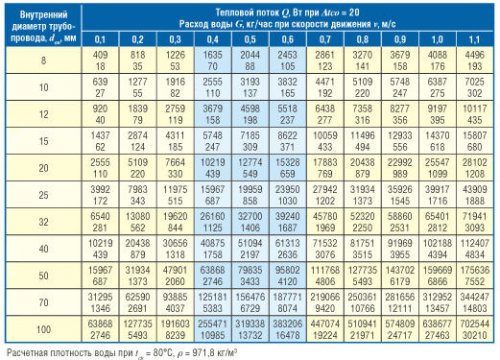
When choosing pipes for water supply, it should be borne in mind that copper and polypropylene pipes are recognized as the most reliable and durable. Moreover, copper is also the most expensive. To install a water supply system using plastic pipes, you will need soldering iron... Plumbing device from metal-plastic pipes produced on threaded connections, which greatly simplifies and speeds up the installation process.
The range of pipes for the communication device is extensive. The manufactured products differ significantly in their characteristics: material, flexibility, strength, durability. It is often difficult for the user to determine which pipe to choose for the water supply of a house or apartment. The type of pipeline and the medium being transported, the number of plumbing points in the network are all factors that tug the scales in favor of choosing one type or another.
The internal water supply system includes a piping system (wiring) that transports water to plumbing and equipment. Pipes and connecting elements made of polyethylene, polyvinyl chloride, polypropylene, polybutylene, metal polymers may not be used for all networks. Each of them has its own operating conditions and they can vary greatly.
Pipes made of copper, brass, bronze can be used without restrictions - for systems with high pressure, for transporting drinking and technical, cold and hot water. Steel products with external and internal corrosion-resistant coating can also be used for any purpose.
To avoid possible damage, plastic pipes are hidden in baseboards, channels, special shafts. Open installation is allowed for connections to plumbing, in safe places - behind the bathroom, behind the toilet cistern, etc.
For each type of pipes and their standard size, the value of the maximum pressure in the network, which they can withstand, is determined. It is better that it be higher than the maximum possible pressure in the water supply network.
For example, in a house with a centralized water supply, the pressure can fluctuate between 2.5-7.5 bar at a rate of 4 bar. In this case, peak values \u200b\u200bcan sometimes reach 10 bar, and the system is tested at values \u200b\u200bof 12 bar. To prevent the pipeline from bursting, when choosing pipes, a "safety margin" is provided with a reference to maximum performance.
When choosing pipes for the construction of external underground systems, they pay attention to the ring stiffness index. For channelless laying of a polymer pipeline in soil, in which it may be damaged, products with a protective coating are used.
How to determine the required pipe size
To conveniently determine the diameter of pipes and fittings, bind them to all elements of the system, use the value of the inner diameter ( D y- conditional pipe passage). Focus on the typical dimensions of steel pipes - they are produced with D y - 15 mm, 20 m, 32 mm.
The length of the supplied steel pipes can be different, mostly these are lengths from 4 to 12 m. Reinforced-plastic pipes can have a diameter ( D y) 16-30 mm and wall thickness 2-2.5 mm.
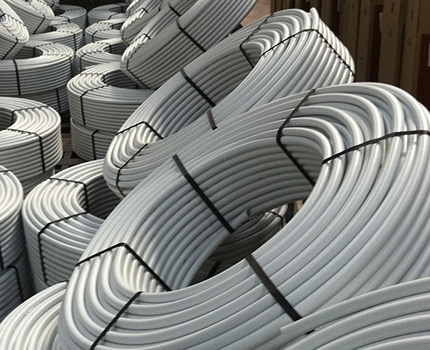
Reinforced-plastic and plastic pipes are supplied to wholesale and retail trade networks in coils or pieces. The total length of products should be with a margin - 2-5% more than envisaged in the project (if this stock was not initially included in it)
The choice of the diameter of the future pipeline depends on the following factors:
- Water pressure in the network. The lower it is, the larger the diameter should be. A thin pipe with insufficient pressure will give only a thin stream of water.
- Length of the pipeline. The greater its length, the lower the pressure in the network and, accordingly, it is necessary to use a larger diameter.
- The number of turns and seams. Each such element reduces pressure. By choosing pipes with a large diameter, it is possible to increase the flow of water into the house.
These factors are related to the properties of the pipeline itself. In addition to them, water temperature, parameters of pumping equipment and much more are taken into account.
There are special formulas for an accurate calculation of the diameter, but general rule when buying - do not incline your choice in favor of saving by reducing the diameter of the pipe. In a narrow pipeline, more hydraulic losses occur, which will have to be compensated for by a more powerful pump and more electricity required for its operation, and this is an additional cost.
When installing a pipeline in an apartment, most often there is no need for calculations - there is already a wiring at the entrance. Its dimensions are known, they are designed for the required water consumption. Usually, before entering the apartment, the common pipeline is assembled from pipes, D ywhich is 20-32 mm, pipes with Dy15-20 mm.
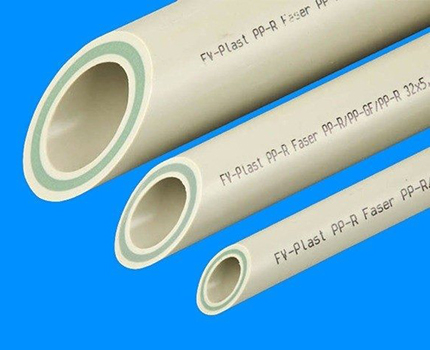
The diameter of polymer pipes can be different for different types... But since the entry of the pipeline into the apartment, as a rule, is made of steel, in the production of polymer products, manufacturers often focus on the possibility of connecting them to pipes with standard values
Differences between pipes by materials for production
When choosing pipes for water supply from a certain material, take into account the physical and mechanical characteristics, as well as the operating conditions - the maximum indicators of temperature, working pressure, service life. All parameters are prescribed in regulatory enactments and must meet state standards.
Metal pipes - basic properties
The main thing for which a metal pipeline is valued is its strength, resistance to high temperatures, overpressure in the network and external mechanical damaging influences. But those few shortcomings of such products sometimes cross them out of the list of products available and convenient for installation.
Firstly, it is low corrosion resistance, if it is not copper or brass pipes, significantly reduces the service life, worsens qualitative indicators plumbing in general. Secondly, the large weight, which creates additional difficulties during installation. And thirdly, the problems that arise when connecting different parts plumbing - the need for threading and the inaccessibility of shaped products made of expensive metals.
Galvanized and non-galvanized steel pipes
The products are used for the installation of external and internal water supply networks, hot and cold mains. They can be galvanized and not galvanized. The first ones last a little longer and are less clogged. But over time they also lose protective layer and also as non-galvanized ones begin to rust. On average, steel pipelines last about 40 years.
Steel pipes are produced with different wall thicknesses, according to these parameters they are divided into light, ordinary, reinforced. The thicker the wall, the longer the product lasts and vice versa. Reinforced pipes are harder to cut and require more bending forces.
Pipes are easy to gas weld, but, nevertheless, their installation is more difficult to carry out than the installation of a pipeline made of other materials. In addition, welding is not always possible and not in all rooms.
Steel assemblies and parts are ordered from specialized workshops and shops. To connect pipes, threads are cut on them:
- half an inch if D y\u003d 15 mm;
- three quarters of an inch at D y\u003d 20 mm;
- one inch if D y\u003d 25 mm.
They are called respectively half-inch, three-quarter-inch and inch pipes.
The main disadvantages of a steel pipeline are weak anti-corrosion properties and a high degree of clogging. It must be periodically cleaned of the formed plaque, otherwise it loses its throughput. In this case, you can not use alkaline agents that corrode the metal, and pipes begin to leak over time.

Copper piping - aesthetics and durability
Copper piping is least of all susceptible to negative factors that affect strength and service life. It does not corrode, does not form a deposit, does not deform due to a change in temperature. When interacting with chlorine compounds contained in the water of the centralized water supply system, it does not form harmful compounds.
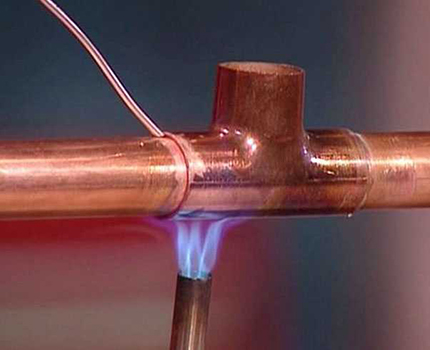
Copper pipes are easy to process - they can be easily bent or connected using gas welding or high-temperature brazing
If we compare the copper pipeline with other types of pipes for water supply, then we can note its extremely high cost. This is perhaps his biggest drawback. But he has served for over 70 years. It is often used if it is impossible to carry out hidden installation of the water supply system, and the aesthetics of the room must be preserved.
Plastic pipes: types and characteristics
The choice of plastic pipes is made taking into account their purpose, operating conditions - the temperature of the water used, the maximum working pressure, etc. Despite the similarity of the material for production, the properties of different types of products can be very different.
Differences between plastic and other types of pipes
Due to the many positive characteristics, plastic pipes are very often used in the design and construction of pipelines. They are primarily characterized by high corrosion resistance.
Unlike metal products, they do not require a special protective coating, have a lower weight, which simplifies and facilitates the process of installation and transportation. Their inherent flexibility allows you to reduce the number of bent inserts, connecting elements.
Plastic pipes have a flat, smooth surface and, thanks to this, have a small hydraulic resistance, increased throughput (do not clog). They do not corrode and have low thermal conductivity, which prevents condensation.
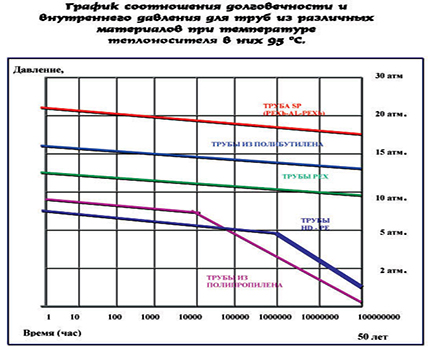
The predicted service life of the plastic pipeline is 50 years. But at the same time, it must be remembered that the manufacturer indicates the timing for the operation of the product at a certain and stable temperature regime
Among the disadvantages - they are easily damaged, exposed to negative effects of negative temperatures, becoming brittle. It is strongly not recommended to carry out the installation at subzero temperatures. They should not be used when arranging wiring sections near open sources of fire and in places of direct sunlight.
The temperature of the water transported through the pipeline, which differs from the standard indicators, also has a negative effect on the service life of the products. In addition, plastic pipes during storage, transportation and operation must be protected from sunlight and mechanical damage.
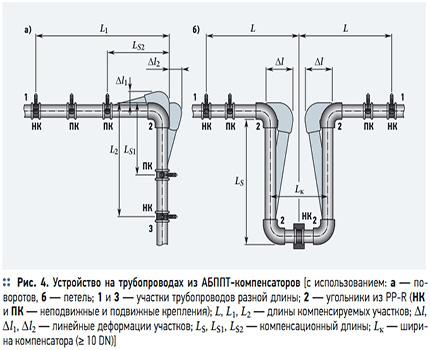
The problem of linear expansion inherent in plastic pipes is solved with the help of special expansion joints that bend when heated and cooled.
Types and characteristics of plastic pipes
Plastic pipeline is general characteristics products made on the basis of plastic. This includes products made of polyethylene, polypropylene, unplasticized polyvinyl chloride.
A polyethylene (PE) pipeline is used to supply cold drinking water with a temperature of 0 ° C to 40 ° C, with a maximum working pressure not exceeding 25 bar (the exact value depends on the pipe size). The elements are assembled by welding.
Polypropylene pipes (PP) include several types of products that may slightly differ in the composition of raw materials for production and are designated as PPH, PPR and PPB. They are used for the transportation of household and drinking water (except for those used for fire safety networks).
Withstand temperatures of 70-80 ° C, have a reduced resistance to bending and shock loads. These properties are especially pronounced at subzero temperatures. The pipes, depending on the class of operating conditions, can withstand a pressure of 4, 6, 8 or 10 bar. Their connection is carried out by welding, with a special butt or socket soldering iron, as well as by thermistor welding.
Unplasticized polyvinyl chloride (PVC-U) pipes are suitable for transporting water for any purpose with a temperature from 0 ° C to 45 ° C. It is unacceptable to use this type of product for hot water. It can be used for external above-ground and internal cold water supply networks, subject to protection from sunlight and mechanical damage. The connection of the parts is carried out in the socket using glue.
Units and parts for the installation of a plastic pipeline are manufactured at the factory. A wide selection of their configurations and sizes makes it easy to assemble the most complex plumbing systems.

For each type of polymer pipes, manufacturers stamp parts with a specific configuration. Therefore, it is necessary to choose only the same type of pipes and assemblies.
How to determine quality when buying
During the acquisition, unwinding of coils or installation, make sure that there are no flattened sections, fractures and strong bends on the pipes. If such a section is nevertheless found, it must be removed - it is not suitable for installation.
When buying products, they are examined for cracks, burrs, traces of flaking. These defects often appear due to improper storage or transportation. Selectively measure the wall thickness, outer diameter. Check the operability of valves and taps. Shaped elements must be free of breaks, sharp edges, burrs. Rubber gaskets and cuffs should not have tears, cavities.

The presence of defects in the form of peeling layers and bubbles on the surface indicates poor quality of the product, violation of production technology
Each manufacturer of plumbing products must provide data on the properties of the water that can be transported through this kind pipes, features of its use, including how to resist the penetration of air into the system. The pipe material should not affect the composition and quality of the water.
Characteristics of a metal-plastic pipe
Pipes made of metal-plastic combine the characteristic properties of metal and plastic - strength, flexibility, corrosion resistance, no plaque. They are made from several layers of durable polyethylene, welded together "overlapping", and an aluminum interlayer, which serves as a frame. The metal layer can be solid, perforated, or spiral.
The base of the pipe is an inner polyethylene layer. It performs a load-bearing function, gives strength, thanks to its smooth surface, it excludes the formation of limescale and layers. The inner aluminum foil layer prevents oxygen from entering the water supply system, stabilizes linear expansion. The outer polyethylene layer protects the inner layers.

The expansion coefficients of metal and plastic are different, and constant temperature jumps over time lead to weakening of joints, leaks. This feature is taken into account when installing pipes and preventing them from tension, and in places of bends, providing for compensation loops
This type of product is intended for the installation of water supply and heating systems. Withstand pressures up to 16 bar and temperatures up to +90 ° C. They can be used to transport both hot and cold water, suitable for cooking and household needs. The service life of a metal-plastic water supply system is 20-50 years, the actual period depends on the quality of installation and operating conditions.
Pipes are supplied from metal-plastic in coils, complete with special fittings designed for their type. Unlike steel pipes, there is no need for threading for metal-plastic pipes; connections are made using special detachable and one-piece fittings.
The installation of the pipeline can be carried out without the use of welding equipment, which means that it can be installed where welding is prohibited.
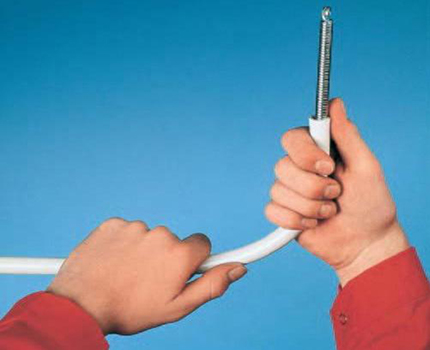
The pipe is afraid of multiple bends. To bend it correctly, use a special spring - pipe bender
Sections of connection of segments and reinforcement are the weak link of the metal-plastic system. Connections must be tightened periodically, at least once every two years. But in general, experts speak well of the properties of metal-plastic pipes and call them one of the most acceptable options in a relatively inexpensive price segment.
Video selection about the nuances of pipe selection
Differences between plastic pipes - polypropylene, polyethylene, metal-plastic:
How to choose pipes for plumbing. Professional Tips:
When buying a pipe for a water supply system, the user most often has to choose the optimal ratio between the price affordable for him and the acceptable quality. Often the choice tends towards the economy of the project. But even among the cheaper offers, you need to carefully study the properties of the product and weigh all the arguments. If doubts remain, then the advice of an experienced specialist will help determine which pipes are best to choose for a water supply system, how to avoid common mistakes.
One of the most important characteristics of a steel pipe is its diameter (D). Based on this parameter, all the required calculations are made when designing an object. How to choose the diameter so as not to be mistaken?
The diameters of metal pipes are standardized and must correspond to the values \u200b\u200bof GOST 10704-91.
They are conventionally divided into several subgroups:
- Large - 508 mm and above;
- Medium - from 114 to 530 mm;
- Small - less than 114 mm.
When it is necessary to carry out a water supply system, ordinary pipes are installed that can withstand a small load. In a private house, it is better to use welded metal plumbing. The cost of such products is slightly lower than similar seamless ones. Specifications and the properties of such a product fully meet all the requirements for laying a water supply system.
Main dimensions
Depending on this characteristic and its numerical value, the required value of the diameter of the metal pipe is determined. All basic values \u200b\u200bare regulated by GOST and the corresponding specifications.
They include:
- Internal D;
- Outside D. It is considered the main dimensional characteristic in accordance with GOST;
- Conditional D. The minimum value of the inner diameter is taken as a basis;
- Wall thickness;
- Rated D.
Metal products and their outer diameters
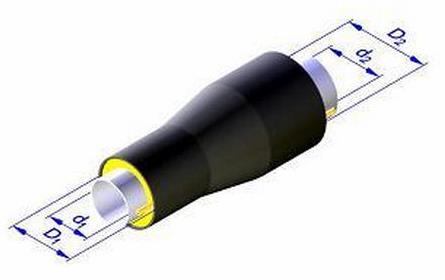
All types of metal pipes are manufactured at the factory based on their outer diameter "Dn". Standard values diameters are shown in the table below.
In industry and construction, products are mainly used with diameters in the range of 426-1420 mm. Intermediate standard sizes water pipes are taken from the table.

Small D metal products are mainly used for laying water pipes in residential buildings.
Medium D metal pipelines are used for laying city water supply. Such water pipes use industrial systemsengaged in the extraction of crude oil.
Big sizes steel pipelines have found application in the creation and laying of oil trunk pipelines. They are also used in the gas industry. Such pipelines supply gas to any corner of the planet.
Inner diameter
This size of the metal pipe (Dvn) can have different meanings. Moreover, the value of external D always remains unchanged. To standardize the diameter of pipes for plumbing, designers use a special value called "nominal size". This diameter has its own designation Dу.
In fact, the nominal width is the minimum value of the inner diameter of a given product, rounded to an integer. Rounding is always performed only towards the maximum value. The value of conditional D is regulated by GOST 355-52.
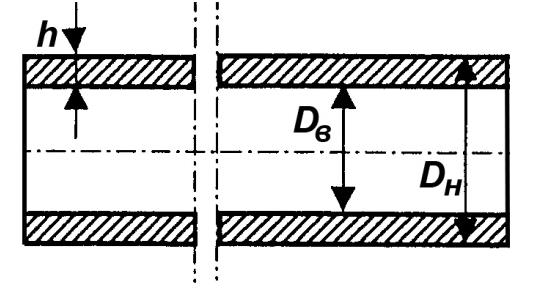
To calculate the internal D, use a special formula:
Dvn \u003d Dn - 2S.
The inner diameters of steel products range from 6 to 200 millimeters. All intermediate values \u200b\u200bare shown in the corresponding table.
The diameter of metal pipes is also measured in inches, which is 25.4 millimeters. The table below shows the product diameters in both inches and millimeters.
Plastic
In our time, an alternative metal pipes their plastic counterparts became. Moreover, their sizes are more varied. The material for such a product is:
- Polypropylene;
- Polyethylene;
- Metal-plastic.
Each manufacturer of such pipes sets its own dimensional grid. Therefore, if one system is being manufactured, it is advisable to use parts from the same manufacturer.
Of course, there will certainly be discrepancies, but they will be minimal and will not cause any particular difficulties for a good master. If a person has little experience, he will have to make some effort to fit all sizes.
A table of sizes of plastic pipes for plumbing using polypropylene of various densities shows the most popular models.
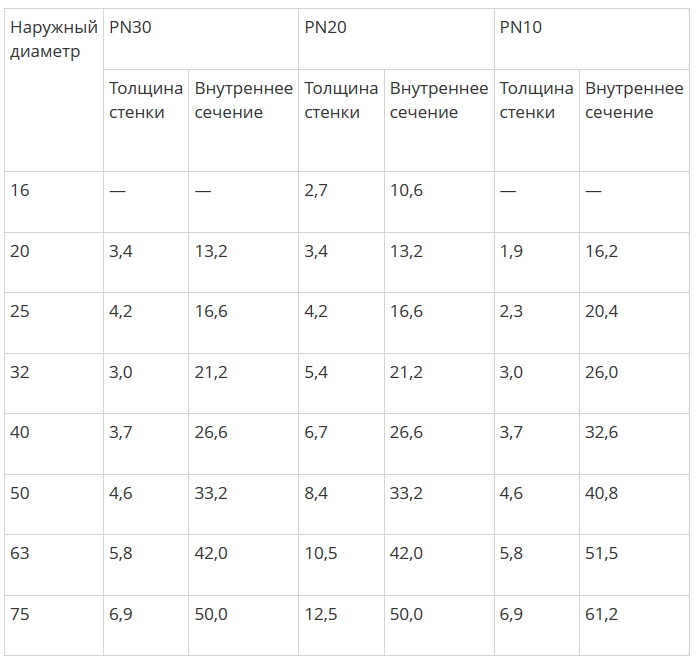
When all kinds of communications are laid, builders use other diameters of plastic water pipes.
The diameters of the water pipes in the table help you select the right product for repairs or other work.
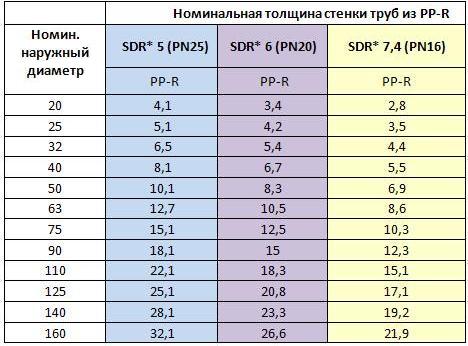
Cast iron
Such products are used for installing plumbing outside the building. In residential premises, a cast-iron water supply system is rarely installed. This material has high strength, but increased fragility. Its main disadvantage is considered to be heavy weight and high cost. The operation of such cast iron products is designed for many years.
To compare the dimensions of cast iron plumbing products, below is a table that shows the dimensions cast iron pipe class "A".
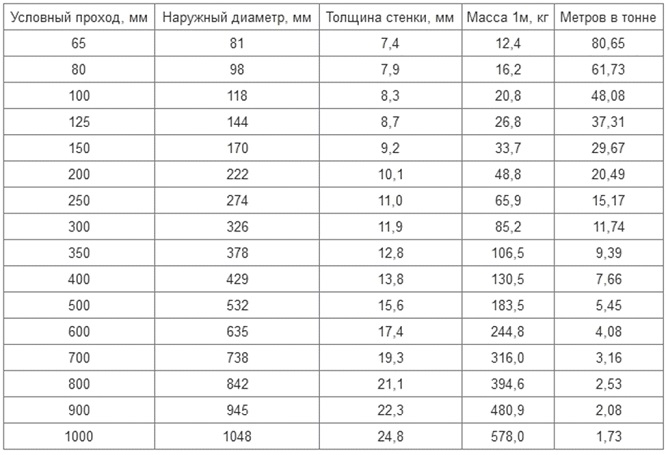
How to translate inches correctly
There are special tables for such calculations. Take, for example, a pipe with D \u003d 1 ″. Outside diameter pipes for the water supply will not have a value of 25.4 mm. The cylindrical pipe thread has an external D \u003d 33.249 mm. Why is this happening?
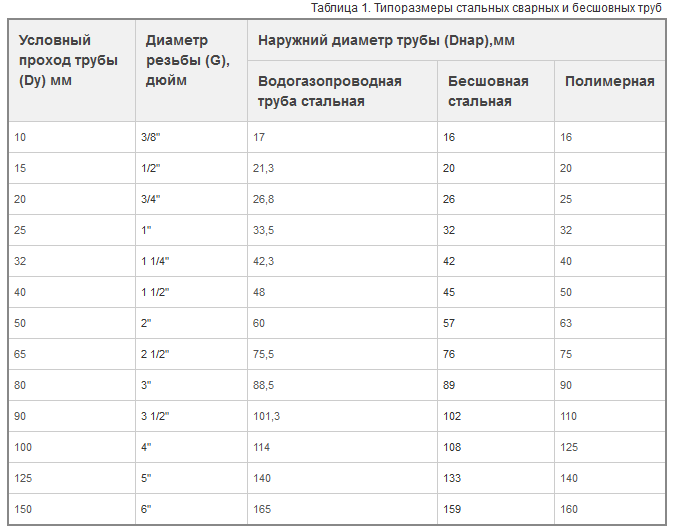
Threading is performed only on the outside diameter. Consequently, the value of the nominal diameter of the tapped thread in relation to the internal value becomes conventional. To calculate the diameter of a pipe for water supply, you need to take 25.4 mm and add the wall thickness multiplied by 2, you get 33.249 mm. The conversion of inch values \u200b\u200bof the diameters of water pipes in mm can be found in the table below.
Standard diameters of steel pipes on the table with wall thickness and weight are regulated by GOST. (For water pipes.)
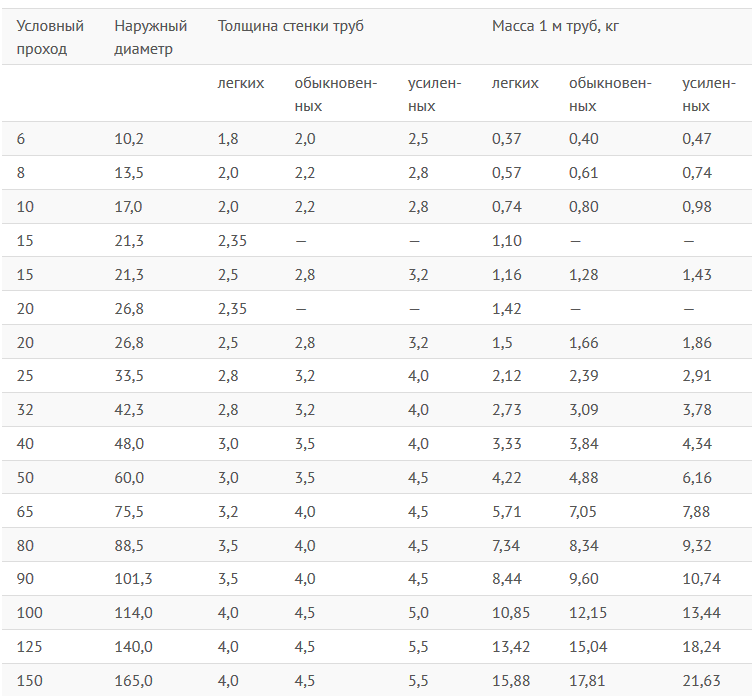
Steel pipes for water and gas (extract from GOST 3262-75)
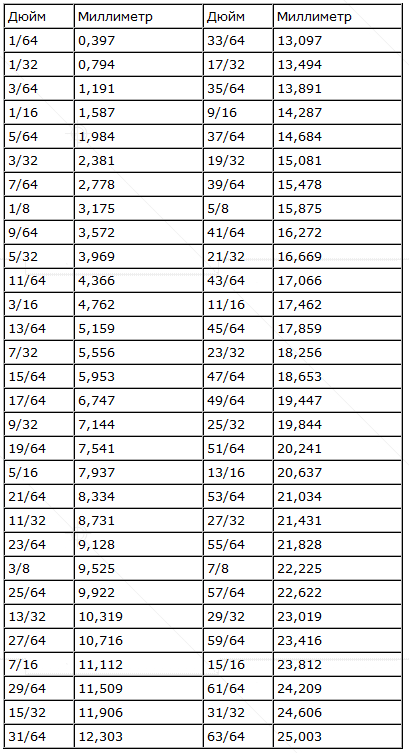 Water pipe diameters table
Water pipe diameters table
The data is shown in the table below
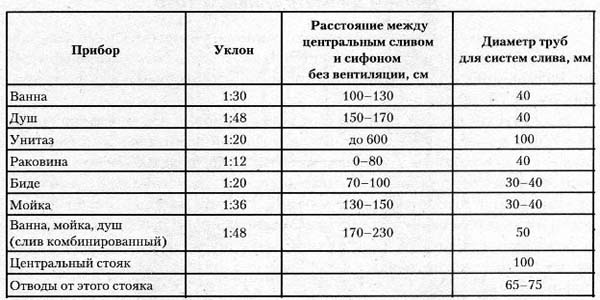
Conclusion
When laying a water supply system, all dimensions of the pipeline must be observed very accurately. Any slightest deviation, even by a millimeter, will not allow creating a tight sealed connection. Such a system will not be reliable and durable. It will definitely flow.

